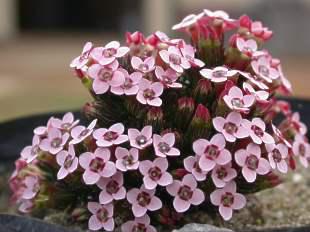Erica fastigiata
Erica fastigiata L.
Family: Ericaceae
Common names: four-sisters heath
Introduction
Erica fastigiata belongs to the largest genus in the Cape Floral Kingdom.

Description
Description
Erica fastigiata is an erect shrub, and can grow to a height of about 1 m. It has a very distinctive arrangement of four flowers at the end of each flowering branch, hence its common name. The corolla is a dark red to purplish cylindrical tube of about 10 mm long. It has a dark greenish or pink ring at the mouth. The broad, spreading lobes vary from pink to pale pink. In the Hottentots Holland form, the dark, central 'eye' or ring is absent. These spectacular flowers occur from August to January.
Distribution and habitat
Distribution description
The plants have a wide distribution and can be found on flats and mountain slopes from Bain's Kloof to Caledon and are abundant in the Hottentots Holland Mountains and Kogelberg of the Western Cape. They grow in seepage areas and can form very dense populations if conditions are favourable. Plants grow best in high-rainfall areas.
Derivation of name and historical aspects
History
Erica is the largest genus in our flora, with about 657 species. Of the 657 species, 625 occur in the southern part of the Western Cape. Erica is drived from the Greek word ereike meaning break. It is believed that an infusion of certain ericas helps break kidney stones. The species name fastigiata is Latin meaning clustered, referring to the arrangement of the branches.
Ecology
Ecology
The tight mouth and broad lobes of the flower suggest that it is pollinated by butterflies and flies with a long proboscis. Seed is wind dispersed.

Growing Erica fastigiata
Grow
This plant is best grown by seed. To achieve optimum germination results, treat seed with smoke treatment before sowing. Sow seed in well-drained soil and cover seeds with a thin layer of soil and water lightly. Once germinated, seedlings can be fed with an organic seaweed-based fertilizer, which will strengthen the root system.
Erica fastigiata grows best in wet seepage areas. Plant among other moisture-loving plants, such as Osmitopsis astericoides, Mimetes hirtus, and E. perspicua.
References
- Bean, A.& Johns, A. 2005. Stellenbosch to Hermanus. South African Wild Flower Guide 5. Botanical Society of South Africa, Cape Town.
- Goldblatt, P.& Manning, J. 2000. Cape plants. A conspectus of the Cape flora of South Africa. Strelitzia 9. National Botanical Institute, Cape Town and Missouri Botanical Garden.
- Schumann, D., Kirsten, G. & Oliver, E.G.H. 1992. Ericas of South Africa. Fernwood Press, Vlaeberg, Cape Town.
Credits
Berenice Carolus
Harold Porter Botanical Garden
December 2005
Plant Attributes:
Plant Type: Shrub
SA Distribution: Western Cape
Soil type: Sandy
Flowering season: Spring, Early Summer
PH: Acid
Flower colour: Pink
Aspect:
Gardening skill: Average
Special Features:
Horticultural zones







Rate this article
Article well written and informative
Rate this plant
Is this an interesting plant?
Login to add your Comment
Back to topNot registered yet? Click here to register.